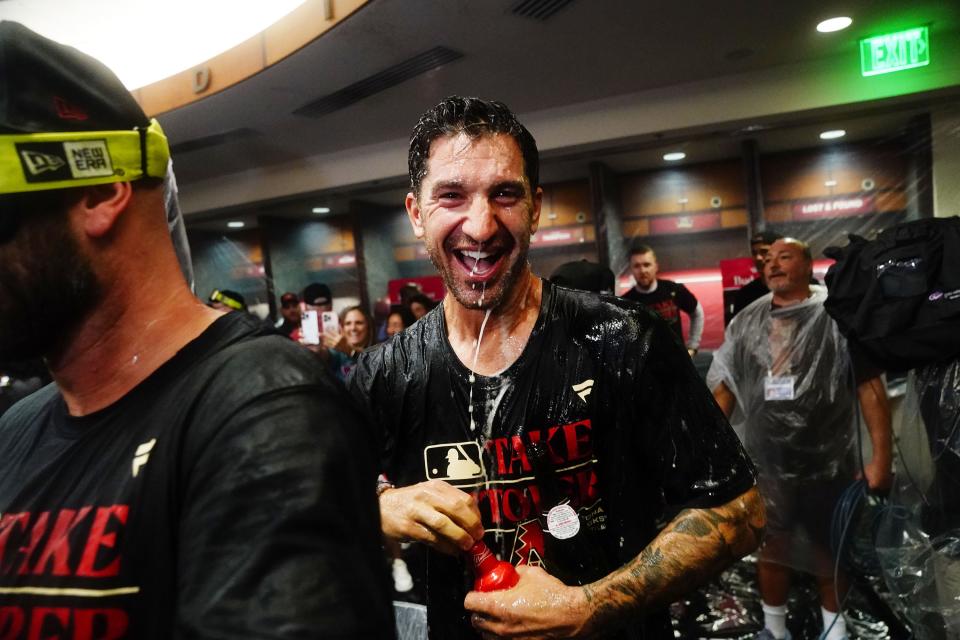How are the Diamondbacks in the World Series? Look no further than their bullpen
PHILADELPHIA — Mike Hazen stood in the Diamondbacks’ clubhouse, his hair and t-shirt equally soaked. This was the first celebration of Arizona’s fall. He could not have known then that it was the first in a lineage that would soon grow to four. Next week, the tally could reach five. Six if parades are included. But what Hazen did know was that his team had a chance. And it had a chance for a very specific reason.
“Our starting pitching has been phenomenal, our bullpen has been fantastic,” Hazen said then. “Those are things that win in the playoffs.”
The success of Arizona’s starting pitching down the stretch was not much of a surprise. Zac Gallen and Merrill Kelly have long been known entities, and the Diamondbacks always expected Brandon Pfaadt to become a strong third piece.
More on Diamondbacks' improbable WS run: 84-win Diamondbacks ‘love proving naysayers wrong’ en route to pennant
The bullpen is a different story. At one point in mid-August, their bullpen ERA was 4.67, fifth-worst in the league. Standing in another champagne soaked clubhouse Tuesday night in Philadelphia, closer Paul Sewald was asked whether he envisioned that unit turning into the driving force for a pennant when he was traded to Arizona at the deadline.
“Why would I have done that? They were the worst bullpen in baseball,” Sewald said, laughing. “There was no reason to think that the bullpen could carry us in the postseason.”
But that’s exactly what has happened. Over the final six weeks of the regular season, the bullpen’s 3.26 ERA was the fifth best in the sport. The playoffs have been even better. Their ERA in 12 postseason games is 2.94.
“Everyone has fit into their roles,” Sewald said. “And it has been incredible.”
Diamondbacks masking weaknesses through the pen
There are endless reasons why the Diamondbacks should not be where they are. They ranked 16th this year in runs scored and 21st in rotation ERA (though the latter number is deflated by players no longer with the club). But the performance of the bullpen has enabled them to hide their weaknesses.
Take Tuesday night’s Game 7, for example. The offense was okay, but not great, scoring four runs. Pfaadt had his moments, striking out seven, but allowed two runs and made it through just four innings.
The bullpen, though, was dominant.
Joe Mantiply entered in the fifth, giving up a double to Kyle Schwarber but retiring Trea Turner and Bryce Harper. Ryan Thompson replaced him, getting Alec Bohm to pop out to end the inning and then working a clean sixth. Andrew Saalfrank allowed two walks but handed the baton to Kevin Ginkel, who escaped the jam he inherited in the seventh and then struck out the side in the eighth. And Sewald closed the door with a 1-2-3 ninth, converting his 12th consecutive save opportunity.

“To come into this environment and stand on a 4-2 lead, … you know you have a very capable bullpen,” Torey Lovullo said.
That performance wasn’t one of isolated dominance. The Diamondbacks have held a lead in nine of their 12 playoff games this year. They’ve won all nine. Their four most trusted relievers — Saalfrank, Thompson, Ginkel and Sewald — have combined to allow five earned runs in 31 innings. That’s a 1.45 ERA.
“They started ripping off some pretty good stuff during the middle of September and really started to carry us,” Hazen said. “And I think, at that point, moving forward, they barely gave up a run.”
Their performances are a testament to the varying avenues through which the Diamondbacks have built their team. Up and down the roster, there are the products of drafting (Corbin Carroll and Alek Thomas), trades (Gabriel Moreno and Zac Gallen) and shrewd acquisitions (Christian Walker and Merrill Kelly). Nowhere is that more evident than in the bullpen.

How Hazen built Diamondbacks' bullpen
Sewald, the closer, was acquired in the way closers are often acquired. Hazen went out and got him at the trade deadline because he believed this team deserved support from the front office, even as their record cratered in July. After a rocky August, he has been dominant since the start of September.
Ginkel has been in the Diamondbacks’ system since he was a 22nd round draft pick in 2016. But before last year, his major league ERA was 4.72. Over the past two seasons, his ERA is 2.76. As recently as June, he was demoted to Triple-A for two weeks. Pitching coach Brent Strom insists he did little with Ginkel, attributing his success to confidence with his wipeout slider.
Saalfrank is an even more surprising player development success story. A sixth round pick in 2019, he was on no one’s radar early in the summer but rode his curveball to a break out season in the minor leagues and an eventual September call-up.
More on how Hazen built DBacks roster: Arizona Diamondbacks aren't in World Series without Hazen, Lovullo
Then there’s Thompson. He was discarded by the Rays in August before the Diamondbacks identified him as a worthwhile minor league free agent signing. By the end of the month, he was on the major league roster. In 13 regular-season innings with Arizona, his ERA was 0.69. Sewald and Ginkel might be more dominant, but he is the glue that holds the operation together, often providing the bridge from the starter to the late innings.
The underlying connection is that none of the four were a key part of the Diamondbacks bullpen early in the season, when it struggled to protect any lead, no matter how large. Now, they’re protecting every lead, no matter how small.
This article originally appeared on Arizona Republic: Diamondbacks' bullpen paved way to World Series vs. Rangers

